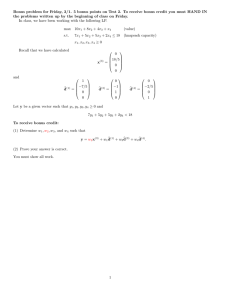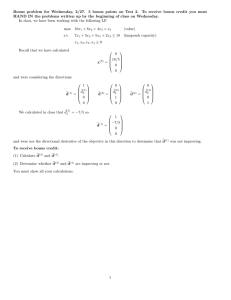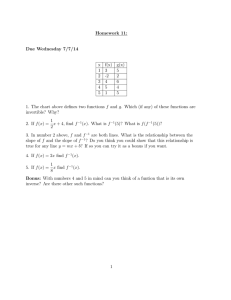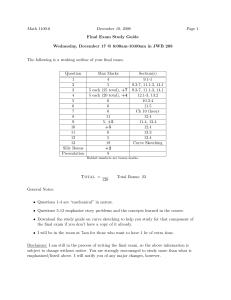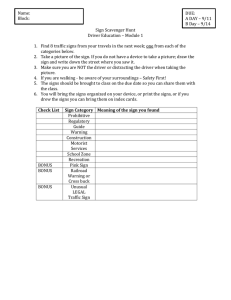Planning Implementation Tools Density Bonus
advertisement
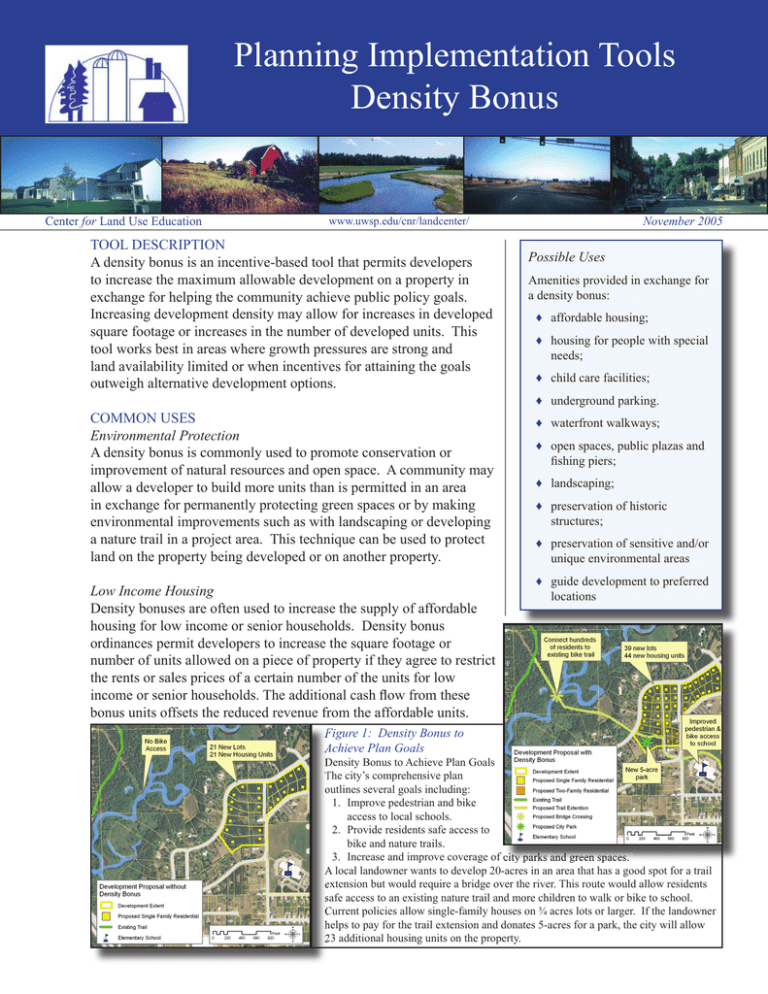
Planning Implementation Tools Density Bonus Center for Land Use Education November 2005 www.uwsp.edu/cnr/landcenter/ TOOL DESCRIPTION A density bonus is an incentive-based tool that permits developers to increase the maximum allowable development on a property in exchange for helping the community achieve public policy goals. Increasing development density may allow for increases in developed square footage or increases in the number of developed units. This tool works best in areas where growth pressures are strong and land availability limited or when incentives for attaining the goals outweigh alternative development options. Possible Uses Amenities provided in exchange for a density bonus: ♦ affordable housing; ♦ housing for people with special needs; ♦ child care facilities; ♦ underground parking. COMMON USES Environmental Protection A density bonus is commonly used to promote conservation or improvement of natural resources and open space. A community may allow a developer to build more units than is permitted in an area in exchange for permanently protecting green spaces or by making environmental improvements such as with landscaping or developing a nature trail in a project area. This technique can be used to protect land on the property being developed or on another property. Low Income Housing Density bonuses are often used to increase the supply of affordable housing for low income or senior households. Density bonus ordinances permit developers to increase the square footage or number of units allowed on a piece of property if they agree to restrict the rents or sales prices of a certain number of the units for low income or senior households. The additional cash flow from these bonus units offsets the reduced revenue from the affordable units. ♦ waterfront walkways; ♦ open spaces, public plazas and fishing piers; ♦ landscaping; ♦ preservation of historic structures; ♦ preservation of sensitive and/or unique environmental areas ♦ guide development to preferred locations Figure 1: Density Bonus to Achieve Plan Goals Density Bonus to Achieve Plan Goals The city’s comprehensive plan outlines several goals including: 1. Improve pedestrian and bike access to local schools. 2. Provide residents safe access to bike and nature trails. 3. Increase and improve coverage of city parks and green spaces. A local landowner wants to develop 20-acres in an area that has a good spot for a trail extension but would require a bridge over the river. This route would allow residents safe access to an existing nature trail and more children to walk or bike to school. Current policies allow single-family houses on ¾ acres lots or larger. If the landowner helps to pay for the trail extension and donates 5-acres for a park, the city will allow 23 additional housing units on the property. IMPLEMENTATION “It is important that density bonuses be directly tied to the goals and objectives of a comprehensive plan. The public should be invited to participate in both the ordinance development process and the site plan review as there may be concerns, especially by adjacent landowners, about the impact of the increased density.” CREATION Density bonuses are typically tied to zoning ordinances or subdivision regulations. There are three basic steps for creating density bonuses: 1. Define the purpose for providing density bonuses. — Goals and objectives in the comprehensive plan should help to define the purpose of a density bonus e.g. encourage developers to protect open space, agriculture, or historical structures, create an amenity such as a trail or public space, or provide affordable housing. 2. Identify the area where the bonuses are allowed. — Areas should be identified that meet program goals. If the purpose is to increase density near public transit for example, then developable land near transit corridors should be identified. If the purpose is to increase affordable housing throughout the city, then all areas in the city are appropriate. Identified areas should be mapped as part of the ordinance. 3. Develop specific policy for allowing bonuses. — A written policy must complement every area identified on the map. Policy language should identify allowable density increases (i.e. total number of units or maximum square footage). If resources are to be protected, legal means, such as easements must be included. (see fact sheet on conservation easements) If amenities are to be created, such as trails, standards must be included for acceptable design, construction, and location. For affordable housing, criteria must designate the number or percentage of affordable units needed for bonus eligibility. Type of housing (single family, duplex, multi-family), income limits, sale price, or rent limits, should also be considered. ADMINISTRATION Developers interested in applying for a density bonus should meet with the appropriate municipal staff to determine if their proposal will qualify for the bonus program. Staff will review the site plan before approving the project to ensure that the granting of the bonus does not have an adverse effect on adjacent properties in the zoning district and that utilities are available to serve the additional units. Land set aside for environmental protection, buffers, greenspace or trails must have restrictions or easements recorded on the deed before construction begins to make sure that they are not developed in the future. Units created as part of an affordable housing initiative will need to be monitored or deed-restricted for the entire time they are part of the program to ensure affordability and compliance. Staff will monitor income eligibility and rent or sales price restrictions. Penalties such as fines should be used to enforce compliance. In place of a municipality, non-profit housing organizations are suitable entities to manage bonus dwelling units designated for affordable housing. Report Card: Density Bonus Cost Money or staff resources required to implement tool. B Public Acceptance B Political Acceptance B Equity No direct cost to the community other than the staff or consultant time to set up the program and administer it. An additional staff person may be necessary if the community chooses to monitor an affordable housing program. The public’s positive or negative perception of the tool. Generally, the public agrees that increasing density in one area while protecting a resource, adding an amenity or offering affordable housing is acceptable. It is important that density bonuses be directly tied to the goals and objectives of a comprehensive plan and that the public be invited to participate in the ordinance development process to increase acceptance of the project Politician’s willingness to implement tool. Elected officials accept this tool if the local citizens see the value of the resource to be protected or the amenity to be added or if the ordinance helps the community to comply with state and federal programs such as affordable housing and environmental protection. Fairness to stakeholders regarding who incurs costs and consequences. A Administration B Scale Municipal to County GRADING EXPLANATION A - Excellent B - Above Average This tool is perceived as fair because the community meets a planning goal at a lower cost and a developer recovers any additional costs from added requirements through an increase in the number of units available for rent or sale. Level of complexity to manage, maintain, enforce, and monitor the tool. Someone must review site plans prior to construction and ensure that any preserved open space is legally protected and amenity construction and maintenance is assigned to the appropriate party. Additional staff may be needed if the community will monitor an affordable housing program. The geographic scale at which tool is best implemented. This tool is generally used at the municipal level but could be used at a larger scale if issues of tax base and service delivery can be solved. C - Average D - Below Average F - Failing Comments and grades were derived from a Delphi process conducted with practicing planners and educators in 2005 WISCONSIN EXAMPLES Figure 2: Husher Highlands (106 acres, not sewered) was initially allowed 21.3 units. The new design included an open space funding mechanism, trail connections, internal and linked open space, and all lots next to open space. Developers received an additional 5 units. City of Madison The City of Madison’s Inclusionary Housing Ordinance uses a citywide density bonus to encourage developers to provide housing for low/moderate (workforce) income families. To receive a density bonus, eligible housing projects of ten or more total units must include a minimum of 15 percent affordable units. The size of the density bonus awarded to developers is determined using a point system. The system awards points based on criteria developed by a committee/commission/council process. Each point earns developers 10-20 percent more allowable units (depending on the number of stories, total units and available parking) up to a three point maximum. For example, if a housing project originally includes 40 units, and the developer earns two incentive points, the developer might receive a bonus of four to eight additional housing units. A special pre-application review process and policy manual is available to developers to determine bonus values and ensure compliance with the ordinance. Village of Caledonia, Racine Co. The Village of Caledonia’s subdivision ordinance mandates the use of conservation design. The goal of the ordinance is to protect and maintain quality open space. The Village offers developers up to an additional 20% density bonus to the number of lots initially allowed if they are willing to include additional standards such as selffunding for open space management, designing internal and external connectivity for trails and open space, designing 75% or more of all lots to abut open space and preserving primary or secondary environmental corridors. FOR MORE INFORMATION Arendt, Randall (1994). Rural by Design: Maintaining Small Town Character Planners Press, American Planning Association, Washington, DC. Pace University Land Use Law Center, White Plains, NY. Incentive Zoning, SERIES III: Innovative Tools and Techniques, Issue Number 7. Available at http://www.law.pace.edu/landuse/bincent.html Regulatory Barriers Clearinghouse, Washington DC. Breakthroughs: Successful local Strategies for Affordable Housing Vol 2, Issue 4. Available at http://www.huduser.org/rbc/newsletter/vol2iss4more.html ACKNOWLEDGEMENTS Document prepared by Douglas Miskowiak and Linda Stoll, 2006. CLUE gratefully acknowledges all external reviewers. Figure 1 developed by Douglas Miskowiak. Figure 2 developed by the Village of Caledonia. This document is part of CLUE’s collaboration with the USDA, NRCS, GEM, and UWEX, entitled, “Partnership for Community Planning – Models for Land Use Education, Planning, and Management.” Center for Land Use Education
